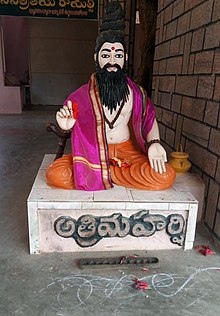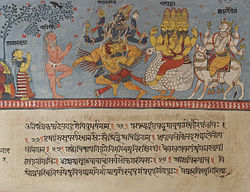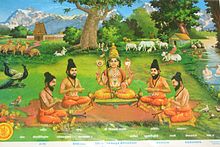Atri
| Atri | |
|---|---|
Anusuya talks with his wife Sita | |
| Affiliation | Brahmarshi |
| Personal information | |
| Parents |
|
| Spouse | Anasuya |
| Children | Durvasa, Chandra and Dattatreya |
Atri or Attri is a Vedic sage, who is credited with composing numerous hymns to
The fifth Mandala (Book 5) of the Rigveda is called the Atri Mandala in his honour, and the eighty seven hymns in it are attributed to him and his descendants.[2]
Atri is also mentioned in the
Legend

Atri is one of the seven great Rishis or
He is said to be a resident of the south in Valmiki Ramayana.[7] The same is supported by Puranic tradition.
Seer of Rig Veda

He is the seer of the fifth Mandala (Book 5) of the
The Atri hymns of the Rigveda are significant for their melodic structure as well as for featuring spiritual ideas in the form of riddles. These hymns include lexical, syntactic, morphological and verb play utilizing the flexibility of the Sanskrit language.[9] The hymn 5.44 of the Rigveda in Atri Mandala is considered by scholars such as Geldner to be the most difficult riddle hymn in all of the Rigveda.[10] The verses are also known for their elegant presentation of natural phenomenon through divinely inspired poems, such as poetically presenting dawn as a cheerful woman in hymn 5.80.[9]
While the fifth mandala is attributed to Atri and his associates, sage Atri is mentioned or credited with numerous other verses of the Rigveda in other Mandalas, such as 10.137.4.[11]
Ramayana
In the Ramayana, Rama, Sita and Lakshmana visit Atri and Anasuya in their hermitage. Atri's hut is described to be in Chitrakuta,[4] near a lake with divine music and songs, the water loaded with flowers, green water leaves, with many "cranes, fisherbirds, floating tortoises, swans, frogs and pink geese".[3]
Puranas
A number of sages named Atri are mentioned in the various medieval era Puranas. The legends therein about Atri are diverse and inconsistent. It is unclear if these refer to the same person, or to different Rishis who had the same name.[4]
Cultural influence

The
Self restraint:
- If material or spiritual pain is created by others, and one is not offended and does not wreak revenge, it is called Dama.
Charity:
- Even with limited income, something should be given away daily with care and liberal spirit. This is called Dana.
Compassion:
- One should behave like his own self, towards others, his own relations and friends, him who envies him, and even his enemy. This is called Daya.
— Atri Samhita, Translated by MN Dutt[14]
The Vaikhanasas continue to be a significant community in South India, and they adhere to their Vedic heritage.[15]
See also
- Abhyasa
- List of Indian philosophers
- Bhartrihari
References
- ^ ISBN 978-0-7914-3696-7.
- ISBN 978-0-19-937018-4.
- ^ ISBN 978-1-317-23877-5.
- ^ ISBN 978-0-14-341421-6.
- ISBN 978-0-7914-3696-7.
- ISBN 81-7505-356-9.
- ISBN 9789333119597.
- ISBN 978-0-19-937018-4.
- ^ ISBN 978-0-19-937018-4.
- ISBN 978-0-19-937018-4.
- ISBN 978-0-19-937018-4.
- ISBN 978-81-208-1087-7.
- ^ Atri (Mahaṛiṣi.); V. Raghunathachakravarti Bhattacharya; Mānavalli Rāmakr̥ṣṇakavi (1943). Samurtarchanadhikarana (Atri-samhita). Tirumalai-Tirupati Devasthanams Press.
- ^ Manmatha Nath Dutt (1908). Yâjnawalkya Samhitâ. Hârita Samhitâ. Us'ana Samhitâ. Angiras Samhitâ. Yama Samhitâ. Atri Samhitâ. Samvarta Samhitâ. Kâtyayana Samhitâ. Vrihaspati Samhitâ. Daksha Samhitâ. Sâtâtapa Samhitâ. Likhita Samhitâ. Vyâsa Samhitâ. Elysium Press. p. 291.
- ^ J. Gonda (1977), Religious Thought and Practice in Vaikhānasa Viṣṇuism, Bulletin of the School of Oriental and African Studies, Cambridge University Press, Volume 40, Number 3, pages 550-571
Sources
- Anthony, David W. (2007), The Horse The Wheel And Language. How Bronze-Age Riders From the Eurasian Steppes Shaped The Modern World, Princeton University Press
- Flood, Gavin D. (1996), An Introduction to Hinduism, Cambridge University Press
- Kambhampati, Parvathi Kumar (2000). Sri Dattatreya (First ed.). Visakhapatnam: Dhanishta.
- Rigopoulos, Antonio (1998). Dattatreya: The Immortal Guru, Yogin, and Avatara. New York: State University of New York Press. ISBN 0-7914-3696-9
- Witzel, Michael (1995), "Early Sanskritization: Origin and Development of the Kuru state" (PDF), EJVS, 1 (4), archived from the original (PDF) on 20 February 2012

